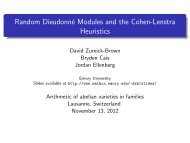alternative lecture notes - Rational points and algebraic cycles
alternative lecture notes - Rational points and algebraic cycles
alternative lecture notes - Rational points and algebraic cycles
Create successful ePaper yourself
Turn your PDF publications into a flip-book with our unique Google optimized e-Paper software.
Let F : C → Set be a functor. Suppose that F preserves all limits. Then F has a left<br />
adjoint L: Set → C. Let ∗ be a singleton. What is L(∗)? We have<br />
This proves the nontrivial half of<br />
Hom C (L(∗), c) ≃ Hom Set (∗, F (c)) ≃ F (c).<br />
Theorem 6.1. Let C be a category with all limits. A functor F : C → Set is representable<br />
if <strong>and</strong> only F it preserves all limits.<br />
What if F preserves only finite limits? Then Pro(F ): Pro(C) → Pro(Set) preserves all<br />
limits, <strong>and</strong> we get P L: Pro(Set) → Pro(C). For c ∈ C ↩→ Pro(C),<br />
Hom Pro(C) (P L(∗), c) ≃ Hom Pro(Set) (∗, Pro(F )(c)) ≃ F (c).<br />
A functor F : C → Set is pro-<br />
Theorem 6.2. Let C be a category with finite limits.<br />
representable if <strong>and</strong> only if F preserves finite limits.<br />
Claim 1: The functor T : Pro(C) → (Set C ) op sending (C i ) to Hom Pro(C) (C i , −) is fully<br />
faithful.<br />
Claim 2: The essential image of T consists of all left exact functors. (Left exact means<br />
“preserves finite limits”.)<br />
Claim 3: For every C with finite limits, the category of left exact functors C → Set is<br />
complete <strong>and</strong> cocomplete.<br />
Proof.<br />
(a) Set C is complete <strong>and</strong> cocomplete.<br />
(b) If E is a complete cocomplete category <strong>and</strong> E ′ ⊆ E is a full subcategory closed under<br />
limits, then E ′ is cocomplete.<br />
□<br />
Back to simplicial sets.<br />
Take a convenient category of nice spaces, such as Top. Let S be the category of simplicial<br />
sets. We have the realization functor S → Top.<br />
Definition 6.3. For X, Y ∈ S , let [X, Y ] S<br />
classes for ∼).<br />
be the set of homotopy classes (equivalence<br />
How does this compare with [|X|, |Y |] Top ? There is an obvious map [X, Y ] S → [|X|, |Y |] Top .<br />
Theorem 6.4. If B is Kan, this map is a bijection of sets.<br />
Theorem 6.5. There exists a functor Ex ∞ : S → S <strong>and</strong> a natural transformation id →<br />
Ex ∞ such that<br />
1) Ex ∞ X is Kan<br />
2) The map X → Ex ∞ (X) induces a homotopy equivalence on realizations.<br />
Example 6.6. If X is the circle having one nondegenerate 0-simplex <strong>and</strong> one nondegenerate<br />
1-simplex, Ex ∞ (X) adds a 1-simplex that wraps around the circle n times, for each n, <strong>and</strong><br />
adds appropriate 2-simplices, etc.<br />
13



